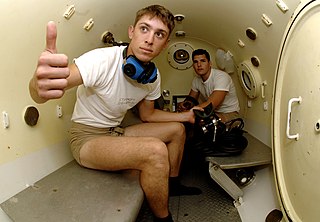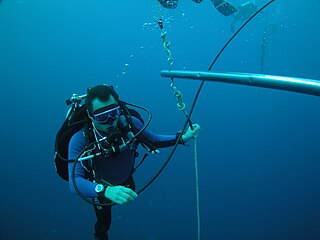Related Research Articles
Nitrox refers to any gas mixture composed of nitrogen and oxygen. This includes atmospheric air, which is approximately 78% nitrogen, 21% oxygen, and 1% other gases, primarily argon. In the usual application, underwater diving, nitrox is normally distinguished from air and handled differently. The most common use of nitrox mixtures containing oxygen in higher proportions than atmospheric air is in scuba diving, where the reduced partial pressure of nitrogen is advantageous in reducing nitrogen uptake in the body's tissues, thereby extending the practicable underwater dive time by reducing the decompression requirement, or reducing the risk of decompression sickness.

Narcosis while diving is a reversible alteration in consciousness that occurs while diving at depth. It is caused by the anesthetic effect of certain gases at high pressure. The Greek word νάρκωσις (narkōsis), "the act of making numb", is derived from νάρκη (narkē), "numbness, torpor", a term used by Homer and Hippocrates. Narcosis produces a state similar to drunkenness, or nitrous oxide inhalation. It can occur during shallow dives, but does not usually become noticeable at depths less than 30 metres (98 ft).

Trimix is a breathing gas consisting of oxygen, helium and nitrogen and is used in deep commercial diving, during the deep phase of dives carried out using technical diving techniques, and in advanced recreational diving.
Heliox is a breathing gas mixture of helium (He) and oxygen (O2). It is used as a medical treatment for patients with difficulty breathing because this mixture generates less resistance than atmospheric air when passing through the airways of the lungs, and thus requires less effort by a patient to breathe in and out of the lungs. It is also used as a breathing gas diluent for deep ambient pressure diving as it is not narcotic at high pressure, and for its low work of breathing.

Deep diving is underwater diving to a depth beyond the norm accepted by the associated community. In some cases this is a prescribed limit established by an authority, while in others it is associated with a level of certification or training, and it may vary depending on whether the diving is recreational, technical or commercial. Nitrogen narcosis becomes a hazard below 30 metres (98 ft) and hypoxic breathing gas is required below 60 metres (200 ft) to lessen the risk of oxygen toxicity.

A breathing gas is a mixture of gaseous chemical elements and compounds used for respiration. Air is the most common and only natural breathing gas, but other mixtures of gases, or pure oxygen, are also used in breathing equipment and enclosed habitats. Oxygen is the essential component for any breathing gas. Breathing gases for hyperbaric use have been developed to improve on the performance of ordinary air by reducing the risk of decompression sickness, reducing the duration of decompression, reducing nitrogen narcosis or allowing safer deep diving

Hypercapnia (from the Greek hyper = "above" or "too much" and kapnos = "smoke"), also known as hypercarbia and CO2 retention, is a condition of abnormally elevated carbon dioxide (CO2) levels in the blood. Carbon dioxide is a gaseous product of the body's metabolism and is normally expelled through the lungs. Carbon dioxide may accumulate in any condition that causes hypoventilation, a reduction of alveolar ventilation (the clearance of air from the small sacs of the lung where gas exchange takes place) as well as resulting from inhalation of CO2. Inability of the lungs to clear carbon dioxide, or inhalation of elevated levels of CO2, leads to respiratory acidosis. Eventually the body compensates for the raised acidity by retaining alkali in the kidneys, a process known as "metabolic compensation".

Gas blending for scuba diving is the filling of diving cylinders with non-air breathing gases such as nitrox, trimix and heliox. Use of these gases is generally intended to improve overall safety of the planned dive, by reducing the risk of decompression sickness and/or nitrogen narcosis, and may improve ease of breathing.

Diving medicine, also called undersea and hyperbaric medicine (UHB), is the diagnosis, treatment and prevention of conditions caused by humans entering the undersea environment. It includes the effects on the body of pressure on gases, the diagnosis and treatment of conditions caused by marine hazards and how relationships of a diver's fitness to dive affect a diver's safety. Diving medical practitioners are also expected to be competent in the examination of divers and potential divers to determine fitness to dive.
High-pressure nervous syndrome is a neurological and physiological diving disorder which can result when a diver descends below about 500 feet (150 m) using a breathing gas containing helium. The effects experienced, and the severity of those effects, depend on the rate of descent, the depth and the percentage of helium.
Hydreliox is an exotic breathing gas mixture of hydrogen, helium, and oxygen. For the Hydra VIII mission at 50 atmospheres of ambient pressure, the mixture used was 49% hydrogen, 50.2% helium, and 0.8% oxygen.
In physiology, isobaric counterdiffusion (ICD) is the diffusion of different gases into and out of tissues while under a constant ambient pressure, after a change of gas composition, and the physiological effects of this phenomenon. The term inert gas counterdiffusion is sometimes used as a synonym, but can also be applied to situations where the ambient pressure changes. It has relevance in mixed gas diving and anesthesiology.
Hydrox, a gas mixture of hydrogen and oxygen, is occasionally used as an experimental breathing gas in very deep diving. It allows divers to descend several hundred metres. Hydrox has been used experimentally in surface supplied, saturation, and scuba diving, both on open circuit and with closed circuit rebreathers.
Equivalent narcotic depth (END) (historically also equivalent nitrogen depth) is used in technical diving as a way of estimating the narcotic effect of a breathing gas mixture, such as nitrox, heliox or trimix. The method is used, for a given breathing gas mix and dive depth, to calculate the equivalent depth which would produce about the same narcotic effect when breathing air.

COMEX is a French company specializing in engineering and deep diving operations, created in November 1961 by Henri-Germain Delauze and ran by him until his death in 2012.

Scuba gas planning is the aspect of dive planning and of gas management which deals with the calculation or estimation of the amounts and mixtures of gases to be used for a planned dive. It may assume that the dive profile, including decompression, is known, but the process may be iterative, involving changes to the dive profile as a consequence of the gas requirement calculation, or changes to the gas mixtures chosen. Use of calculated reserves based on planned dive profile and estimated gas consumption rates rather than an arbitrary pressure is sometimes referred to as rock bottom gas management. The purpose of gas planning is to ensure that for all reasonably foreseeable contingencies, the divers of a team have sufficient breathing gas to safely return to a place where more breathing gas is available. In almost all cases this will be the surface.

The physiology of decompression is the aspect of physiology which is affected by exposure to large changes in ambient pressure, and involves a complex interaction of gas solubility, partial pressures and concentration gradients, diffusion, bulk transport and bubble mechanics in living tissues. Gas is breathed at ambient pressure, and some of this gas dissolves into the blood and other fluids. Inert gas continues to be taken up until the gas dissolved in the tissues is in a state of equilibrium with the gas in the lungs,, or the ambient pressure is reduced until the inert gases dissolved in the tissues are at a higher concentration than the equilibrium state, and start diffusing out again.
Human physiology of underwater diving is the physiological influences of the underwater environment on the human diver, and adaptations to operating underwater, both during breath-hold dives and while breathing at ambient pressure from a suitable breathing gas supply. It, therefore, includes the range of physiological effects generally limited to human ambient pressure divers either freediving or using underwater breathing apparatus. Several factors influence the diver, including immersion, exposure to the water, the limitations of breath-hold endurance, variations in ambient pressure, the effects of breathing gases at raised ambient pressure, effects caused by the use of breathing apparatus, and sensory impairment. All of these may affect diver performance and safety.
The science of underwater diving includes those concepts which are useful for understanding the underwater environment in which diving takes place, and its influence on the diver. It includes aspects of physics, physiology and oceanography. The practice of scientific work while diving is known as Scientific diving. These topics are covered to a greater or lesser extent in diver training programs, on the principle that understanding the concepts may allow the diver to avoid problems and deal with them more effectively when they cannot be avoided.
References
- ↑ Taylor, Larry "Harris". "Diving With Gas Mixes Other Than Air" . Retrieved 2009-03-02.
- ↑ Abraini, JH; Gardette-Chauffour, MC; Martinez, E; Rostain, JC; Lemaire, C (1994). "Psychophysiological reactions in humans during an open sea dive to 500 m with a hydrogen-helium-oxygen mixture". Journal of Applied Physiology. American Physiological Society. 76 (3): 1113–8. doi:10.1152/jappl.1994.76.3.1113. ISSN 8750-7587. PMID 8005852 . Retrieved 2009-03-01.
- ↑ Rostain, JC; Gardette-Chauffour, MC; Lemaire, C; Naquet, R (1988). "Effects of a H2-He-O2 mixture on the HPNS up to 450 msw". Undersea Biomedical Research. 15 (4): 257–70. ISSN 0093-5387. OCLC 2068005. PMID 3212843.